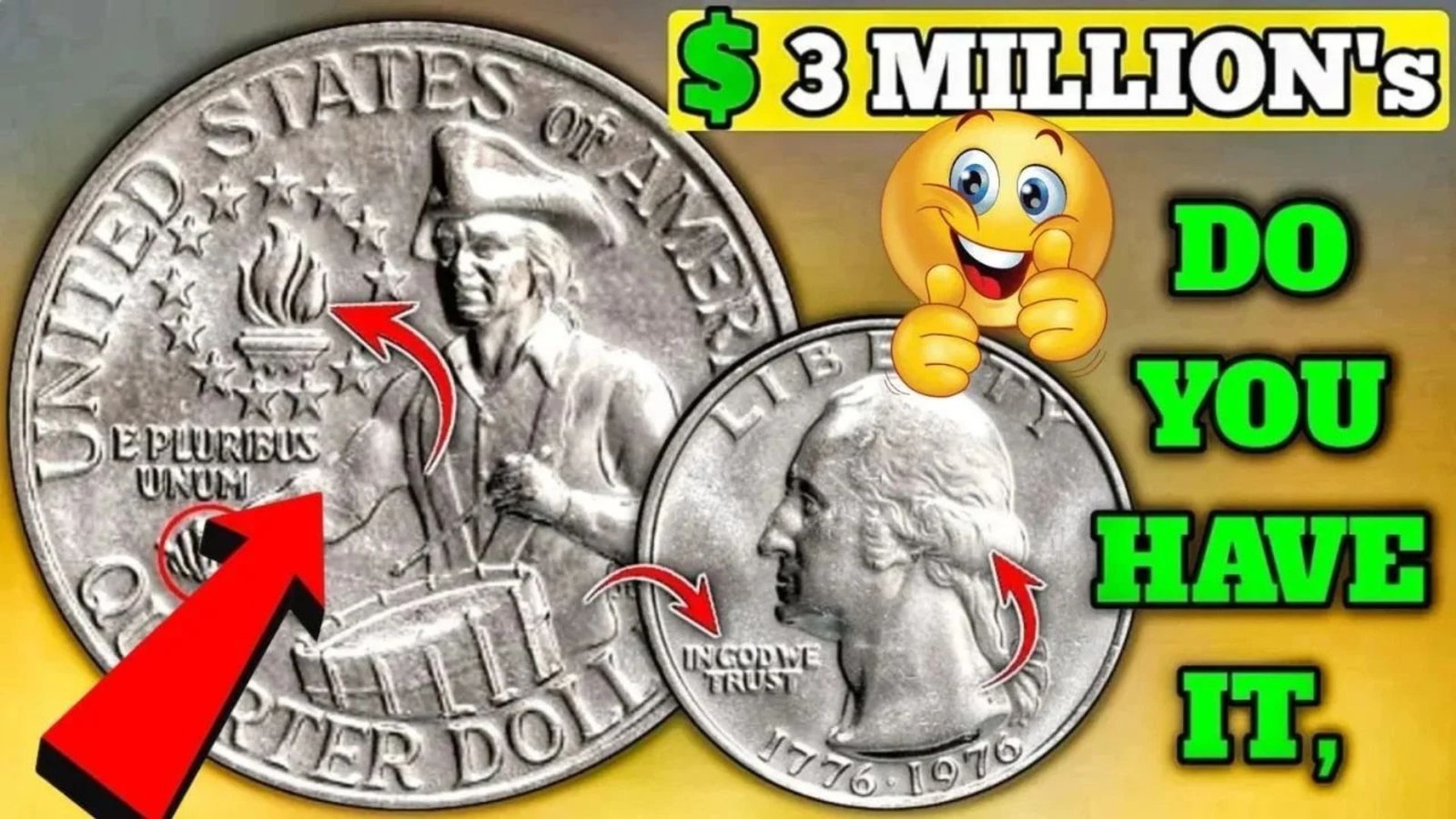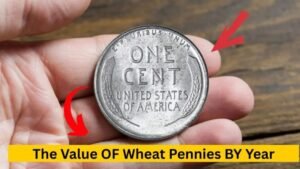In 1976, the United States celebrated its 200th birthday with great enthusiasm, and the U.S. Mint joined the party by creating a special coin called the Bicentennial Quarter. Most of these quarters are worth just 25 cents, but some rare ones can be worth thousands or even millions of dollars! Imagine finding a small fortune in your pocket change or an old coin jar.
This guide will help you understand what makes these quarters so valuable, how to spot them, and what to do if you think you’ve found one. Written in simple language and optimized for search engines, this article will make it easy for you to hunt for a rare 1976 Bicentennial Quarter that could be worth up to $3 million.
What Is the 1976 Bicentennial Quarter?
The Bicentennial Quarter was made to honor America’s 200th anniversary of independence, marked by the signing of the Declaration of Independence in 1776. Unlike regular quarters, this coin has a unique design that sets it apart. It was minted in 1975 and 1976, and over 1.6 billion were produced, so they’re common in everyday change. However, a few special ones stand out due to rare features, errors, or materials, making them highly valuable to collectors.
Why Is It Special?
The Bicentennial Quarter has a distinct look:
- Front (Obverse): Features George Washington’s portrait, like most quarters, but shows the dual dates “1776–1976” to celebrate the bicentennial.
- Back (Reverse): Displays a colonial drummer boy with a torch and 13 stars, symbolizing the original 13 colonies. This design, created by Jack L. Ahr, replaces the usual eagle found on other quarters.
Most of these coins were made of a copper-nickel mix, but some from the San Francisco Mint were struck in 40% silver, which adds to their value. Rare errors or perfect condition can make certain quarters worth a fortune.
Why Are Some Bicentennial Quarters So Valuable?
While most Bicentennial Quarters are worth their face value of 25 cents, a few are prized by collectors due to specific traits. Here’s what makes some of these coins so special:
Minting Errors
Mistakes during the coin-making process can create unique coins that collectors love. These errors include:
- Double Die Error: The design is stamped twice, slightly off-center, making letters or images look blurry. For example, doubling on “LIBERTY” or the date “1776-1976” is highly sought after.
- Off-Center Strike: The design is misaligned, leaving part of the coin blank.
- Wrong Metal Strike: Some quarters were accidentally struck on metals meant for other coins, like a dime’s planchet or silver instead of copper-nickel.
- Missing Mint Mark: A coin that should have a mint mark but doesn’t is rare and valuable.
Silver Content
Most Bicentennial Quarters are clad, meaning they’re made of a copper core with a nickel coating. However, some San Francisco Mint coins were made with 40% silver, especially for collector sets. These silver quarters are heavier and shinier, making them more valuable.
Condition and Grading
The condition of a coin plays a huge role in its value. Coins in “mint condition” (like new, with no wear) are worth more. Professional grading services like the Professional Coin Grading Service (PCGS) or Numismatic Guaranty Corporation (NGC) assign grades from Poor (P-1) to Perfect Mint State (MS-70). A quarter graded MS-68 or higher, especially with errors, can fetch thousands or even millions.
Historical Significance
The Bicentennial Quarter is a piece of American history, celebrating the nation’s 200th birthday. As the U.S. approaches its 250th anniversary in 2026, interest in these coins is growing, driving up their value among collectors.
How to Spot a Rare 1976 Bicentennial Quarter
Finding a valuable Bicentennial Quarter requires a sharp eye and a little know-how. Here’s a step-by-step guide to help you check your coins:
Step 1: Check the Date
Look for the “1776–1976” date on the front of the quarter. This confirms it’s a Bicentennial Quarter.
Step 2: Look for the Mint Mark
The mint mark is a small letter near George Washington’s neck on the front:
- No Mint Mark: Made in Philadelphia.
- D: Made in Denver.
- S: Made in San Francisco, often indicating a 40% silver coin or a proof coin (shiny, mirror-like finish).
Quarters with an “S” mint mark are more likely to be valuable, especially if they’re silver.
Step 3: Inspect for Errors
Use a magnifying glass to look for:
- Double Die Errors: Check for blurry or doubled letters, especially on “LIBERTY,” “IN GOD WE TRUST,” or the date.
- Off-Center Strikes: See if the design is shifted or parts are missing.
- Unusual Appearance: Look for odd colors, like a coppery shine or a silver edge, which could indicate a wrong metal strike.
Step 4: Check the Weight
Weigh the coin using a precise digital scale:
- Clad Quarters: About 5.67 grams.
- Silver Quarters: About 5.75 grams or heavier.
Silver quarters often have a solid silver edge, unlike the copper stripe on clad quarters.
Step 5: Examine the Condition
Look for coins in great shape with clear details, no scratches, or wear. Uncirculated or proof coins (shiny and mirror-like) are more valuable.
Step 6: Get a Professional Appraisal
If you think you’ve found a rare quarter, don’t clean it—cleaning can lower its value. Store it in a soft plastic holder and take it to a professional coin dealer or grading service like PCGS or NGC for evaluation.
Where to Find Rare Bicentennial Quarters
These valuable quarters could be hiding in everyday places:
- Pocket Change: Check your loose change from stores or vending machines.
- Old Coin Jars: Look through family collections or piggy banks.
- Coin Shops or Flea Markets: Dealers might have rare coins without realizing their value.
- Inherited Collections: Old coins passed down from relatives could include treasures.
- Coin Shows: Attend events where collectors trade and sell coins.
With over 1.6 billion Bicentennial Quarters minted, some rare ones are still in circulation, waiting to be discovered.
Real-Life Examples of Valuable Bicentennial Quarters
Here are some notable auction sales of rare Bicentennial Quarters:
- 1976-S Silver Proof Quarter: Sold for $19,200 due to its high grade and silver content.
- 1976-D Double Die Obverse Quarter: Fetched $8,400 in 2023 for its clear doubling error.
- Double Denomination on a Dime: A quarter struck on a dime planchet sold for $9,200 in 2020.
- 1976-D Clad Quarter with Missing Layer: Valued at up to $3 million due to a unique error showing the copper core.
These examples show how rare errors and conditions can lead to massive payouts.
Types of Bicentennial Quarters and Their Estimated Values
| Type of Quarter | Mint Mark | Material | Estimated Value | Key Features |
|---|---|---|---|---|
| Clad Regular Strike | P or D | Copper-Nickel | $0.25 – $10 | Common, circulated condition |
| Clad Proof | S | Copper-Nickel | $5 – $6,038 | Shiny, mirror-like finish |
| Silver Uncirculated | S | 40% Silver | $10 – $19,200 | Heavier, silver edge, collector sets |
| Double Die Error | D or S | Clad or Silver | $3,000 – $10,000 | Blurry or doubled letters/design |
| Off-Center Strike | Any | Clad or Silver | $500 – $5,000 | Misaligned design |
| Struck on Wrong Metal (e.g., Dime) | Any | Silver or Clad | $9,200 – $3 million | Wrong size or material, rare error |
Note: Values depend on condition, grading, and market demand.
How to Protect and Sell Your Rare Quarter
If you find a potentially valuable Bicentennial Quarter, follow these tips:
- Don’t Clean It: Cleaning can damage the surface and reduce value.
- Store Safely: Use a plastic coin holder to protect it from air, moisture, or scratches.
- Get It Graded: Send it to PCGS or NGC for professional grading to confirm its authenticity and value.
- Sell Wisely: Work with reputable coin dealers, auction houses like Heritage Auctions, or platforms like eBay for authenticated sales.
- Check Auction Records: Research recent sales of similar coins to estimate value.
Why Collectors Love Bicentennial Quarters
These quarters are more than just money—they’re a piece of American history. The unique drummer boy design and the “1776–1976” date celebrate the nation’s independence, making them sentimental keepsakes. Rare errors, silver content, and pristine condition add to their appeal, especially as the U.S. nears its 250th anniversary in 2026. The thrill of finding a valuable coin in everyday change keeps collectors and hobbyists excited.
Conclusion
The 1976 Bicentennial Quarter is a fascinating piece of American history that could be hiding a fortune. While most are worth just 25 cents, rare versions with errors, silver content, or perfect condition can be worth thousands or even millions. By checking the mint mark, weight, and condition, and looking for errors like double dies or off-center strikes, you might uncover a treasure in your pocket change, coin jar, or family collection.
Always get a professional appraisal to confirm value, and store your coin safely to preserve its worth. Start your treasure hunt today—you never know when you might find a rare 1976 Bicentennial Quarter worth up to $3 million!
FAQs About the 1976 Bicentennial Quarter
Are all 1976 Bicentennial Quarters valuable?
No, most are worth only 25 cents. Only rare ones with errors, silver content, or perfect condition are highly valuable.
How can I tell if my quarter is silver?
Silver quarters, usually with an “S” mint mark, weigh about 5.75 grams and have a solid silver edge, unlike the copper stripe on clad quarters.
What errors should I look for?
Check for double die errors (blurry letters or designs), off-center strikes, or coins struck on the wrong metal, like a dime planchet.
Where can I get my quarter appraised?
Take it to a professional grading service like PCGS or NGC, or consult a reputable coin dealer at a coin show or shop.
Can I still find these quarters in circulation?
Yes, some rare Bicentennial Quarters are still in pocket change, old collections, or vending machines, though finding a valuable one is rare.
How do I sell a rare quarter?
Get it graded by PCGS or NGC, then sell through trusted coin dealers, auction houses like Heritage Auctions, or platforms like eBay.




